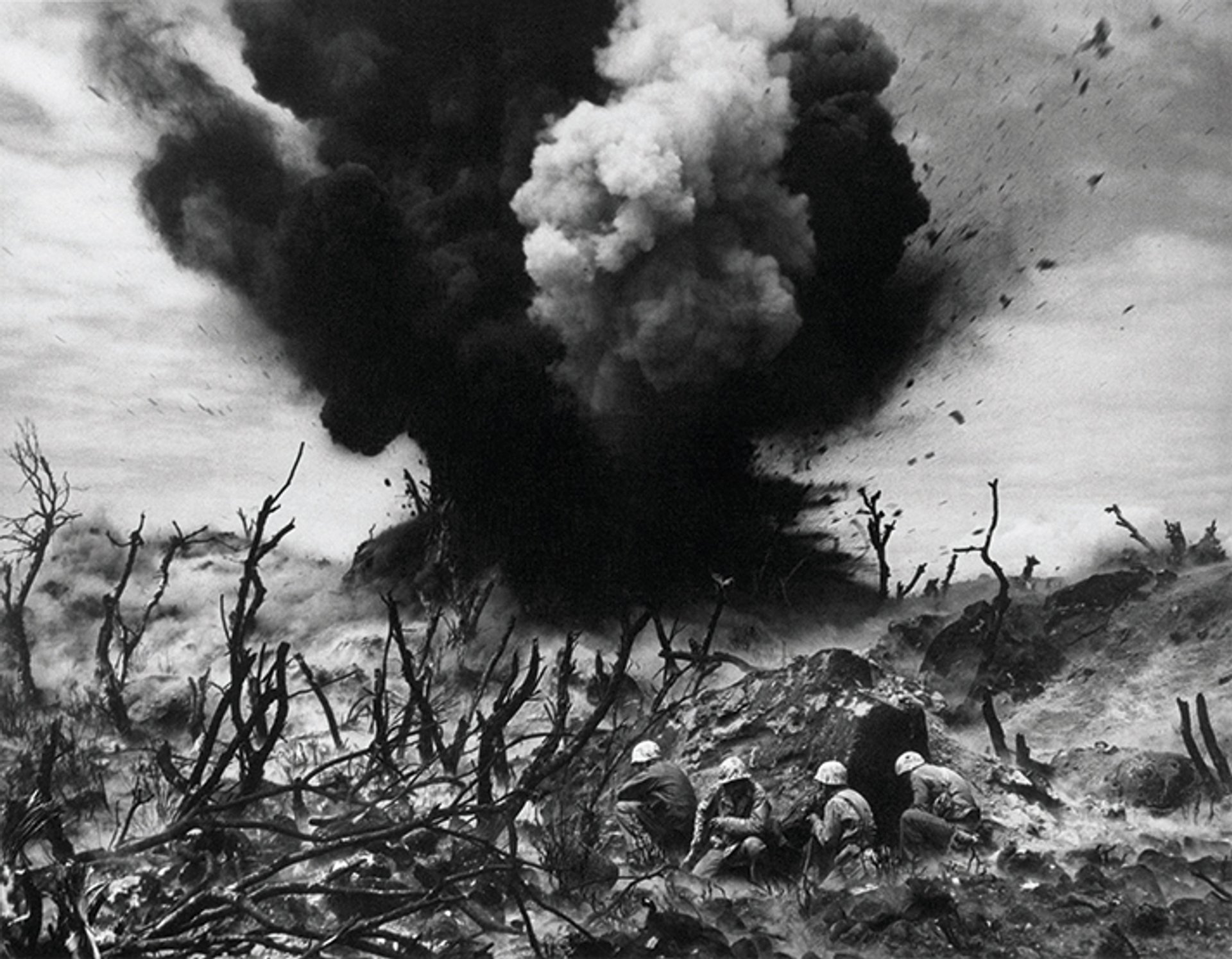“What is America?” Peter van Agtmael’s question, in the introduction of Magnum America: The United States, is a perennial one but is often pondered more deeply following a presidential election. Few countries in the world spend so much time projecting their sense of self. Yet the reality of America is often far from the vision of a shining city on a hill. From the Second World War onwards, the Magnum Photos agency has dispatched photographers to try and find the essence of the US through imagery.
Below, Van Agtmael, the American photojournalist who co-edited the book, has selected seven images from the new compendium that try and capture the soul of America.

© W. EugeneSmith/Magnum Photos
W. Eugene Smith
US Marine demolition team blasting out a cave on Hill 382, Battle of Iwo Jima, Japan, February 1945
“Actual combat is often high on drama, short on meaning. This picture looks like a scene out of a Hollywood movie, perhaps because Hollywood takes so much inspiration from reality. But for some reason, 80 years later, it remains one of the most powerful and strongest images of war, even though it’s not an image of great violence. Having been in kind of similar situations, this feels like someone else’s memory of my own experience.”

© Danny Lyon / Magnum Photos
Danny Lyon
Student Nonviolent Coordinating Committee photographer Clifford Vaughs being arrested by the National Guard, Cambridge, Maryland, 1964
“It’s not necessarily an especially well-known picture of Danny Lyon’s or an especially well-known picture of the civil rights movement. The person that showed it to me was the artist Hank Willis Thomas. I was like: ‘holy shit, how did I miss this extraordinary photograph?’ I was captivated by its power: the scene of this guy getting ripped in four, all the soldiers wearing gas masks, these disembodied forms. This is a part of Maryland which is still pretty economically and racially segregated in a lot of ways.”

© Elliott Erwitt
Elliott Erwitt
Florida Keys, 1968
“You could describe this picture a thousand ways and it wouldn't have the same impact it does when you just look at it. This was taken in 1968, a pretty climactic year. Is it also a comment on the civil rights movement? Who knows what was going on in Elliott Erwitt’s subconscious. You never know how much your critical eye is working and how much your subconscious is working when you take a photograph. In photography, visual worlds often coexist, just as they do in reality. We appreciate the quotidian, and we appreciate the painful and the horrific, when they're balanced. When they're all able to breathe together.”

© Jim Goldberg / Magnum Photos
Jim Goldberg
“We are always very affectionate together.” … “My mom looks pretty. I look scared.” San Francisco, California, 1979
“This is a Jim Goldberg image from the 1980s, which was the decade that seemed to indicate a real shift in the way photography was interpreted at Magnum. It's when when colour really started emerging, which brought different sensibilities to the fore. The early traditions of Magnum were about finding the single, definitive photograph that says everything and becomes a monument to history, a symbol of a person or a happening or circumstance. I think, as time has gone on, you realise that the photograph often obscures much as it reveals.”

© Alec Soth/Magnum Photos
Alec Soth
A lockdown drill interrupted an eighth-grade gym class at Belle Plaine High School, Minneapolis, Minnesota, 2014
“This is a picture of a lockdown drill, which is intended to address the threat of school shootings. It mirrors an earlier picture in the book of school kids taking cover for a nuclear bomb drill. But now, fast forward a few decades, and nuclear bombings are not the number-one threat—citizens with semi-automatic weapons are. There’s this undertone of violence that cuts through the heart of American society, both domestically and abroad.”

© Bruce Gilden/Magnum Photos
Bruce Gilden
New York City, 1986
“I got to know Bruce’s pictures of New York when I first moved there. He was capturing the thing that I was sensing and seeing in the city but didn’t know how to define. Bruce has always gotten to the heart of New York. His photographic style feels so much a part of the city: a lot of attitude, a lot of brashness and a certain roughness but still a beauty and refinement in there.”

© Carl De Keyzer/MagnumPhotos
Carl De Keyzer
The Living Christmas Tree—the Calvary Baptist Temple, Savannah, Georgia, 1990
“This is an image of a group of men who I believe are singing from within a giant Christmas tree. It’s from the series God, Inc. Everything is real in these pictures, but the images themselves are so deeply surreal. The US is often banal on the surface, but there’s a weirdness always lurking just below the surface. If you go looking for it, it’s everywhere.”
• Magnum America: The United States, Peter van Agtmael and Laura Wexler (eds), Thames and Hudson, 472pp, £125 (hb)





